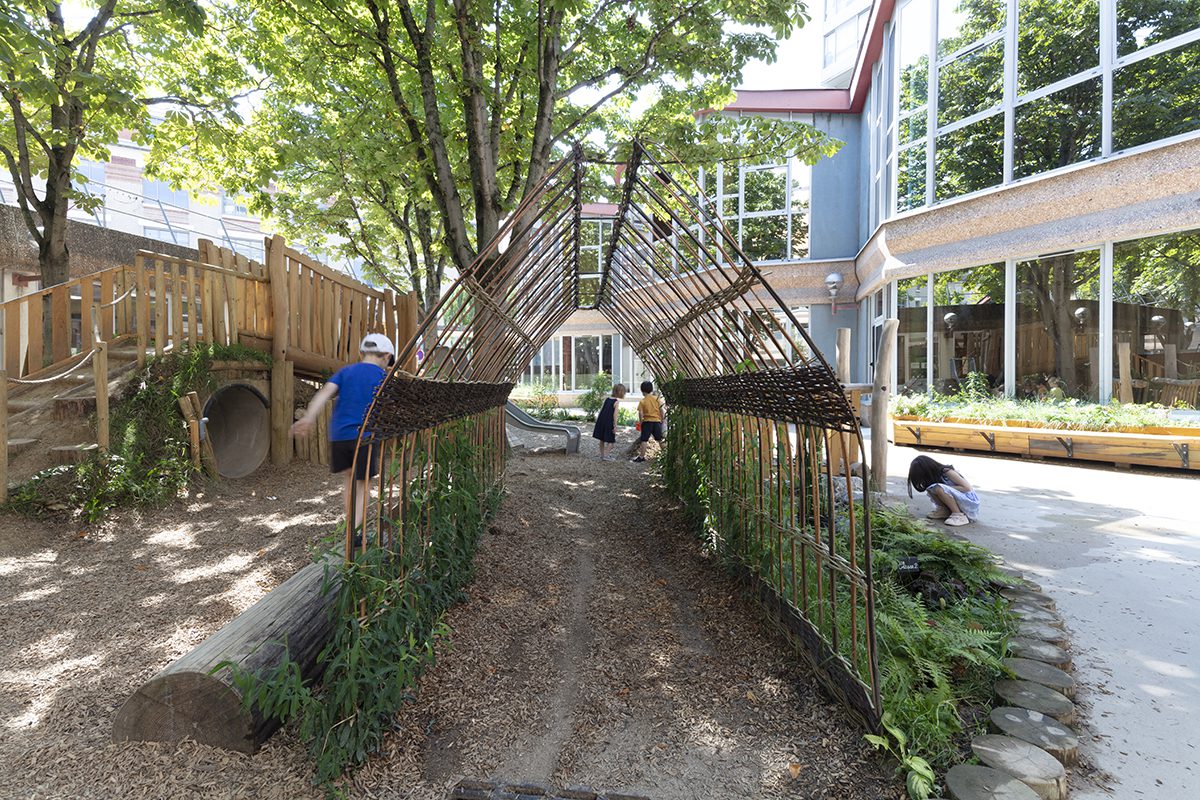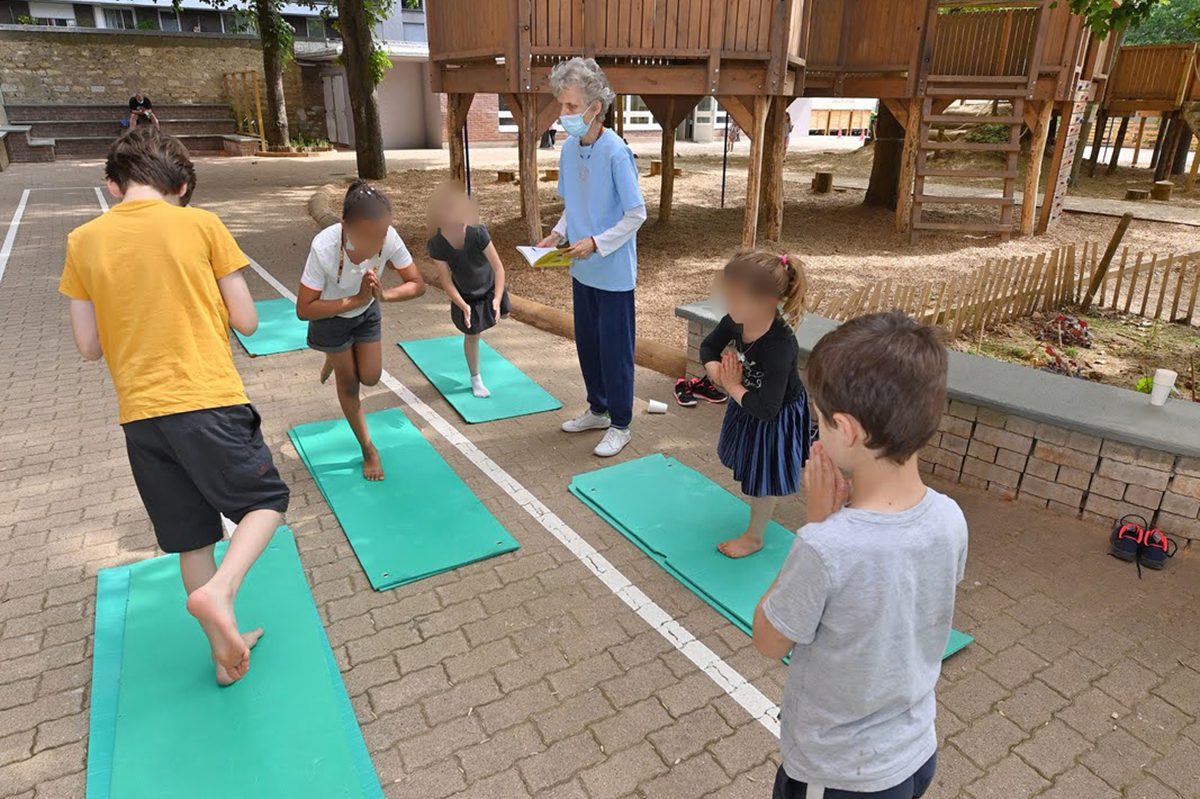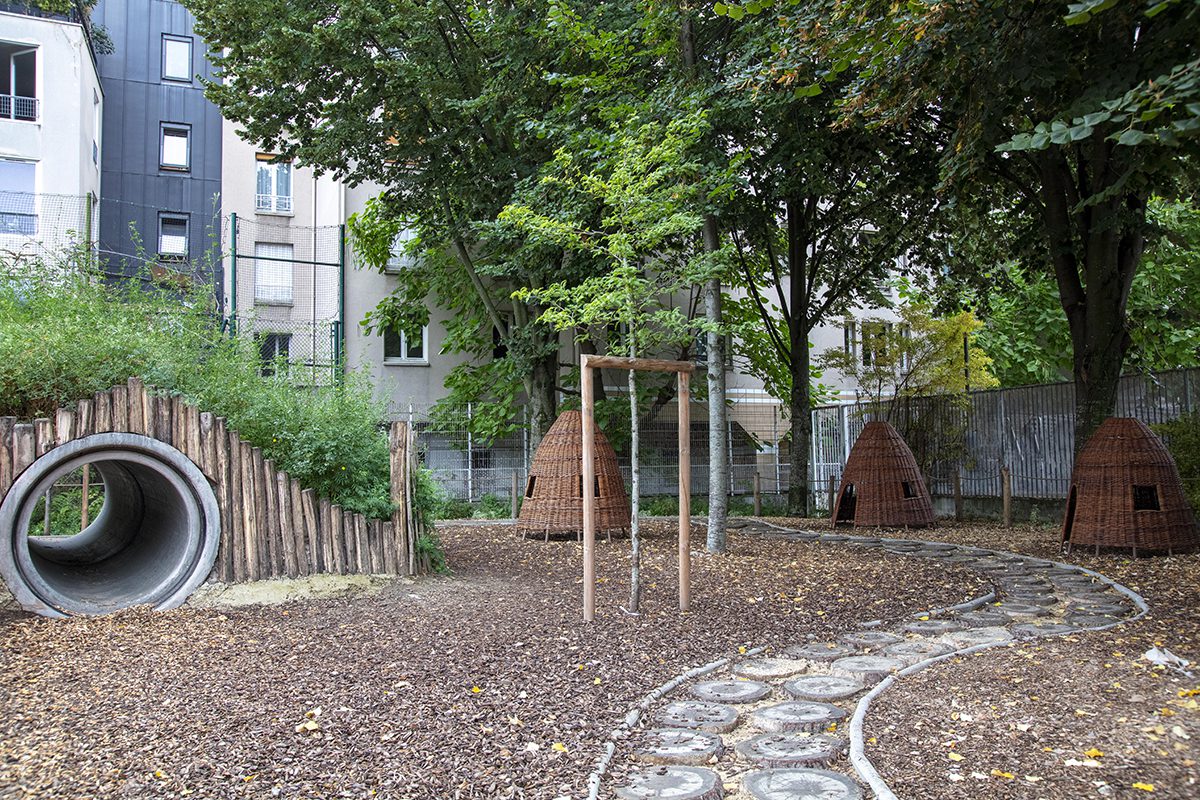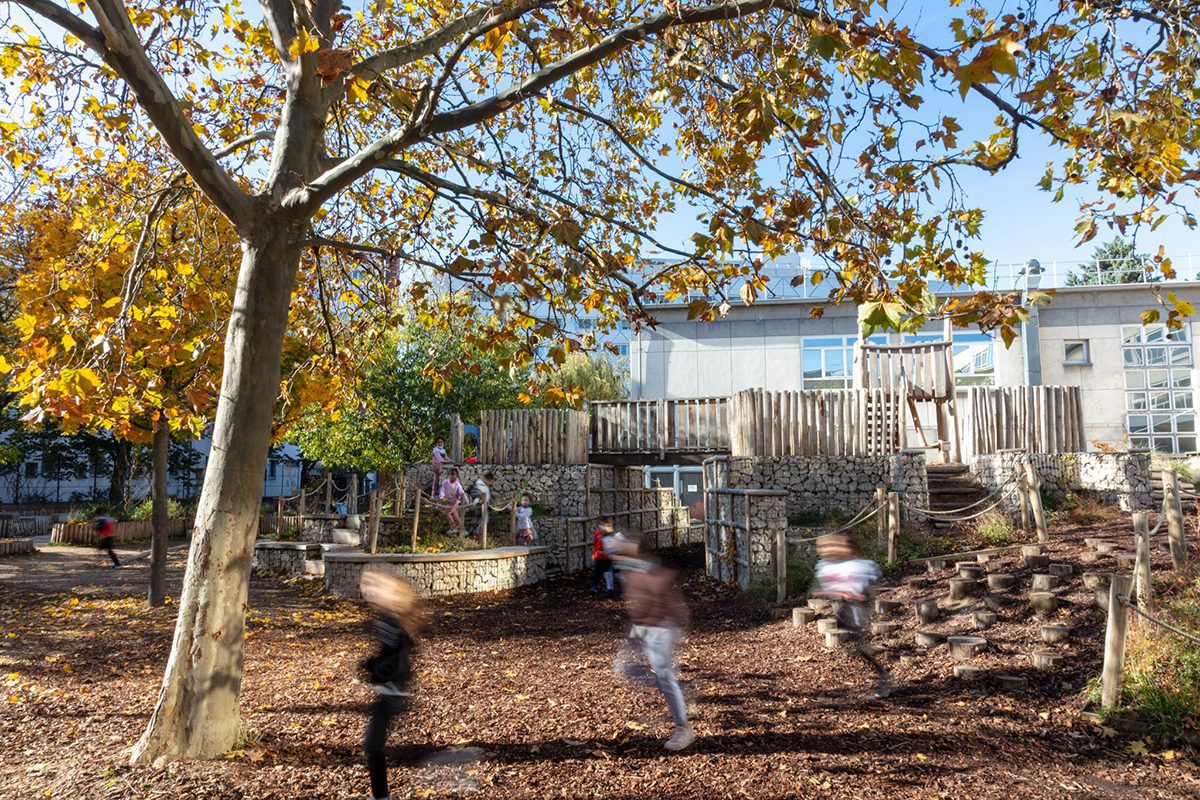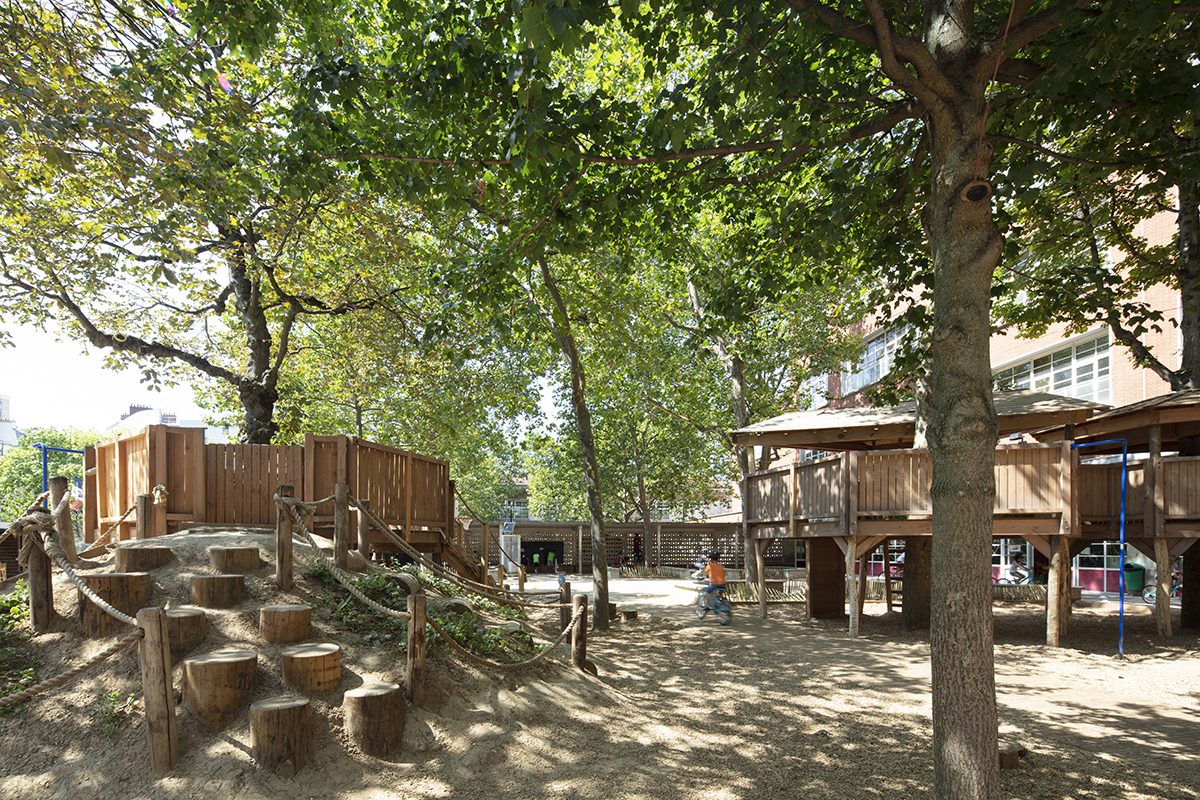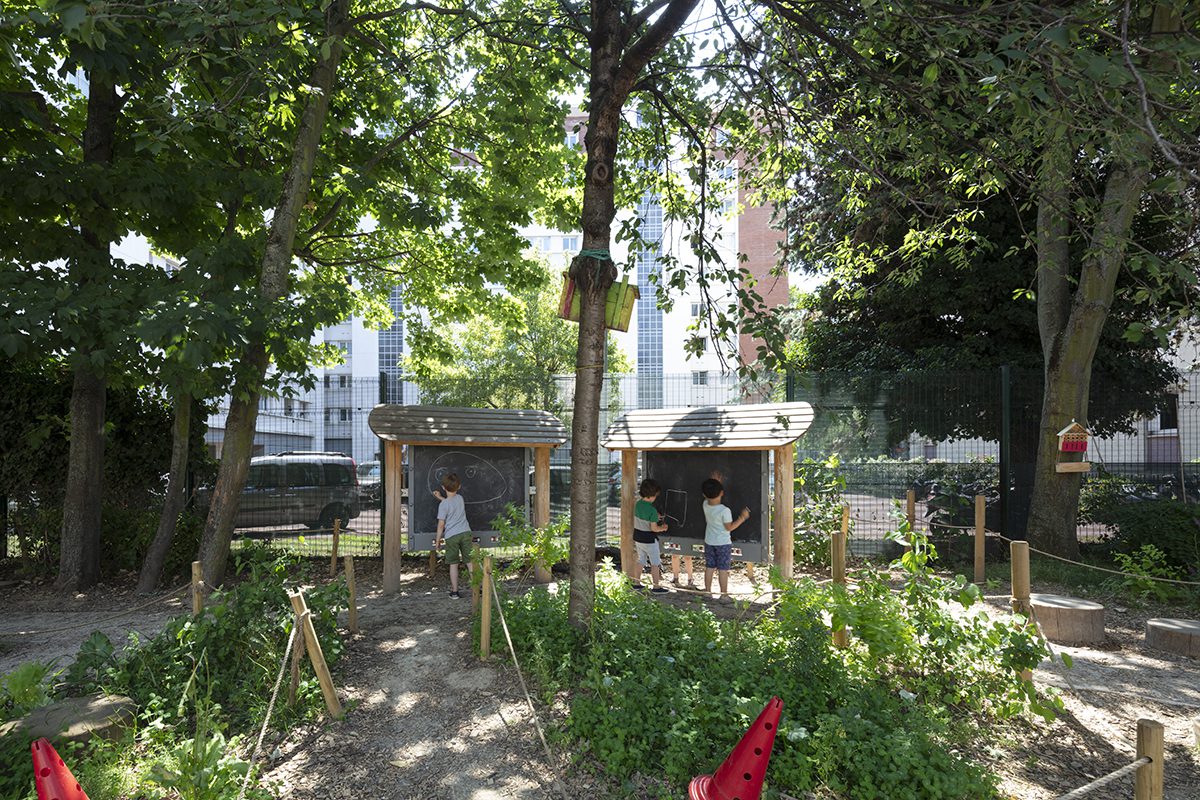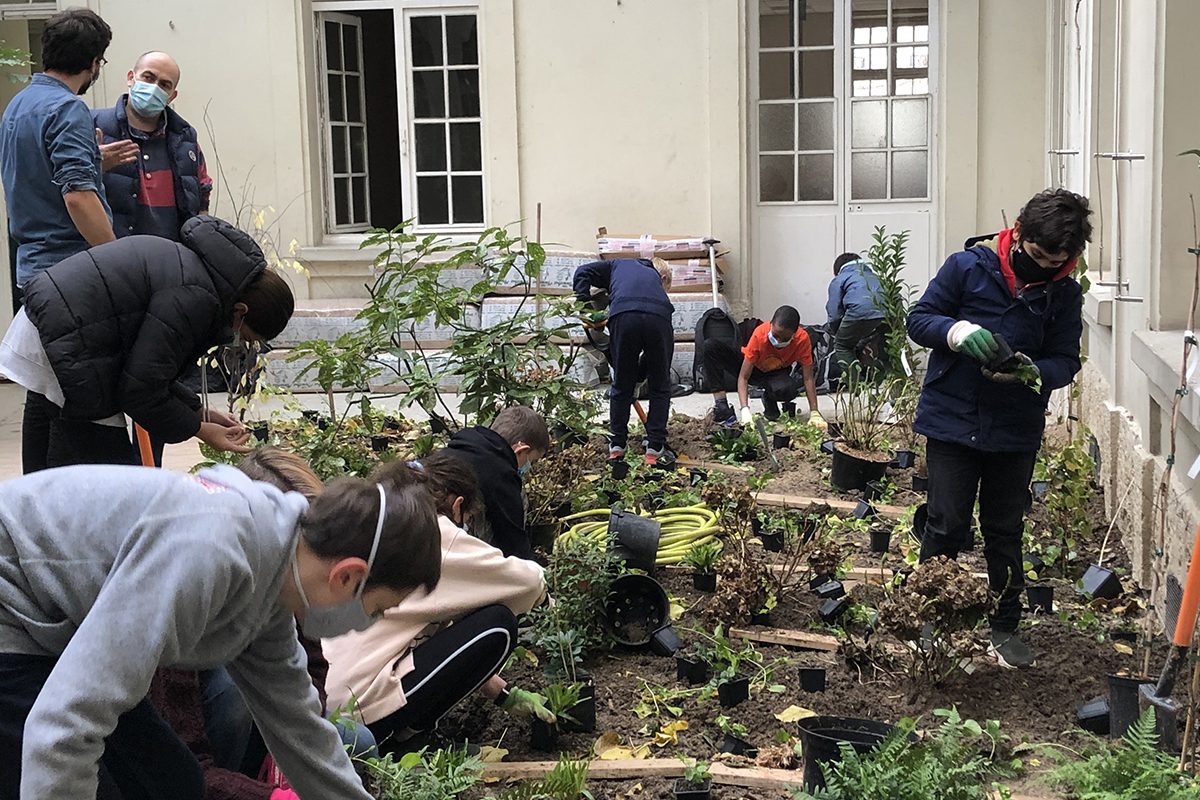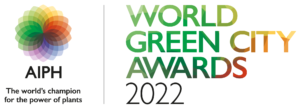Addressing the urban challenge
Breadth of the issue – How are the problem(s) that are being tackled by your initiative affecting citizens/local businesses or a significant component of the local wildlife?
The loss of nature in the city has caused a decrease in environmental qualities, and on the counting of fauna and flora species. Due to global warming, heatwaves have become more and more frequent in the city, bringing consequences to every living being (animal, human or vegetal) of the area. In the Oasis project, children are the priority target group, since they suffer from the consequences of climate change in their daily lives. The asphalt-covered schoolyards increase city’s temperature, while failing to offer good quality development and playing spaces for children. Furthermore, they lack connection with nature, and lose the chance to learn about biodiversity and the benefits of nature as a part of the pedagogical programs.
In order to respond to those identified issues, the Oasis project has pledged to dedicate 30 -50 percent of the schoolyards’ total surface to natural environment, and to implement pedagogical activities for environmental education. In that matter, pedagogical gardens have been created, along with natural playing areas. Children learn how to interact with nature and how important it is to take care of it for the benefit of the planet.
Another target of the project is the vulnerable population in the local community, such as the elderly, who are particularly at-risk during heatwaves. For that reason, schoolyards’ openings on Saturdays seek to create ephemeral pocket parks in the city, with comfortable temperatures for them to enjoy, close to their homes.
Depth of the issue – How seriously are the problems being tackled by your initiative impacting the life of the citizens/businesses/wildlife concerned?
By the end of the century, Météo France projects an increase in the average annual temperature of 1°C to 4°C for a reference value of 12.4°C, as well as 10 to 25 days of heat waves. The decline of biodiversity and the threat to fragile natural ecosystems is a consequence of urbanisation and densification. To face these risks, elementary and middle school schoolyards have been identified as important assets: they represent a total city’s surface area of more than 70 hectares and are evenly distributed over the territory. Mainly asphalted and impermeable today, these spaces participate massively in the development of the urban heat island effect. Moreover, they are closed to the public on weekends, despite the fact that Paris lacks convivial, refreshing spaces that are accessible to all.
Regarding these challenges, some of the main benefits of the project are:
- The increase on green spaces within the city, while providing children with richer playgrounds to develop and stimulate curiosity and links with nature, for example, through gardening activities and climate change awareness
- The contribution on decreasing greenhouse effects in urban spaces by the provision of natural temperature regulators such as threes and natural soil covers
- The increase of the citizen’s knowledge on the city’s biodiversity
- The possibility for residents to take advantage of accessible and pleasant spaces close to their homes, with the aim of strengthening social ties in the neighbourhood.
The power of plants and natural ecosystems to deliver benefits
How is the initiative shaped by scientific evidence of the potential for plants and natural ecosystems to deliver benefits?
One of the objectives of the Oasis project is to recreate greater biodiversity in schoolyards, to raise awareness among young people of the importance of creating and protecting a natural environment in the city. Indeed, nature is a very important source of well-being for everyone (as exposed in UNICEF discussion paper on The Necessity of Urban Green Space for Children’s Optimal Development) and guarantees a better quality of life in the city. To defend this vision of the city, the City of Paris relies on both internal and external expertise. Within the City, a large amount of work has been carried out to promote the restoration of green, blue, and brown networks (see Paris.fr website “La biodiversité à Paris”). Specialists in biodiversity issues have contributed to the project in the design phases of the new schoolyards, specifying the importance of creating more natural spaces (creation of different plant strata, installation of facilities to accommodate small fauna, etc.). These recommendations were taken into account in the first schoolyards. Furthermore, external researchers are also involved in the evaluation of the project, which allows the adjustment of the technical solutions deployed in the natural courses, in order to make them even more effective from the point of view of ecosystems’ restoration. Finally, exchanges with researchers contribute to enabling the first users of the schoolyards, the students, to be sensitized to nature and to better understand its functioning, in particular with participatory projects, where the children become actors in the collection of scientific data.
How has the city exploited the potential of plants and associated ecosystems to deliver more than one benefit?
The greening of schoolyards, in addition to restoring biodiversity in the city, also aims to combat the urban heat island effect. Plants play a very important role in improving the local microclimate. This is especially the case of trees, which provide both shade and significant evapotranspiration. The species are chosen to be respectful of the local biodiversity (indigenous species) and for their resistance to the challenges of climate change. Plants are therefore able to contribute to better rainwater management, as planted areas contribute to soil permeability and groundwater recharge. Some plants can contribute to soil decontamination as well. Finally, green spaces have a significant role in absorbing CO2 for better air quality. All these benefits are developed within the framework of the Oasis project where green spaces represent between 30% to 50% of the transformed schoolyards’ areas.
These new spaces become learning landscapes and create connections between students and nature and promote a greater awareness of the challenges of climate change and the importance of nature in the city.
Furthermore, natural areas contribute to the wellbeing of the inhabitants, especially those who can access schoolyards on weekends, having a positive impact on mental health. Finally, they play a role in the better sharing of space, as the green spaces in schoolyards are more spontaneously used by both girls and boys, without any gender division.
Innovative and Collaborative Solution
How does the initiative show evidence of feasibility, including on-going financial and logistical support?
As the project has been running since 2018 without interruption, it has already proven the relevance of its implementation and the capacity of the city of Paris and its partners to implement it. It lies on an ongoing and evolving process of adjustment that allows the identification of new technical solutions, the strengthening of the place of nature and the transformation of professional practices. The feasibility is also assured by a constant interaction between the European Union, the Public Sector, the private sector, the counselling sector and civil society stakeholders on a local scale, as it has been explained on the precedent points.
Finally, the project has also received strong political support from the beginning, which has allowed it to be promoted and displayed, and has also made it possible to assign it a dedicated budget and to mobilise the City of Paris’ services. The financial funds of the project are assured by the City of Paris, the State and the Seine Normandy Water Agency. Between 2019 and 2021, the Oasis project was co-financed by the Urban Innovative Actions (UIA) program of the EU European Regional Development Fund. The yearly budget is of 10 M€, for an average of 25 schools intervened per year.
In what ways is the initiative innovative?
Oasis innovation lies in the holistic dimension of the project, and the co-benefit concept. The project is dealing with climatic, social, and educative issues. Interdisciplinary teams work on the main claims of the project, from different perspectives. On one hand, the fight against the urban heat island effect is materialized in the de-impermeabilization of schoolyard’s soils, the suppression of asphalt areas, and the soil remediation (treatment of pollutants stocked underground from former land uses of the area). In parallel, the plantation of indigenous species (more than 50%) is mandatory, and new hosting spots for small fauna species are created. A dynamic on existing material’s upcycling and reuse has been implemented in some of the transformed schoolyards. On the other hand, a brand-new initiative of the city has been implemented, by the creation of new semi-public places on Saturdays -through the schoolyards’ opening- as a catalyst for social cohesion. This action seeks to foster inter-generational relationships in the neighbourhood, as the newly transformed schoolyards are suggesting many activities that promote shared activities for local residents of all ages. Finally, the transformations of the schoolyards are designed through participatory workshops and implemented with a broad interaction of multiple stakeholders and users: students, teachers, extra-curricular teams, parents, and local administration. The Oasis projects are a great opportunity for the whole school communities to discover and to learn together to conceive and use a schoolyard through an innovative way.
How is the initiative supported by collaborative working across disciplines and sectors?
The Oasis project is an interdisciplinary project. Along the process, several sectors and stakeholders intervene. A back-and-forth dynamic is created between:
- The public sector: the main coordination of the project belongs the City of Paris. Cross-expertise from several Departments (Education, Green and Technical Departments) of the city are mobilized. Educators, architects, engineers, civil engineers, environmental experts and biologists put their knowledges and perspective into the project, concerning aspects like needs and benefits for the children, design of the new schoolyards, rainwater management technical solutions, greening possibilities, construction works etc.
- The counselling sector: a sustained alliance has been made with the Architectural, Urban Planning and Environmental Council (CAUE). This stakeholder implements participatory and co-creation workshops with children and pedagogical teams. Social geographers, hydrologists, climatic researchers from academic laboratories are leading studies and impact monitoring processes for the project and advising the City of Paris.
- The associative sector (free-collaboration legally constituted groups of civilians) proposes recreational activities for children and their families during opening hours on Saturdays.
- The private sector carries construction works in the schoolyards, in the frame of public
regulations.
These different actors put their skills at the service of the project. The combination of these different expertise through project reviews, operational meetings, experience sharing, and joint training is a guarantee of continuous improvement. The City of Paris and its partners are therefore implementing a genuine shared management process that allows for the joint search for new solutions.
How does the initiative demonstrate evidence of community support?
There is a large variety of stakeholders involved through the process. The schoolyard’s transformation process starts with co-design phases with the children. Students have given positive feedback, by recognising the importance for them to be taken into account and being able to express their desires and opinions for their playground. Their insights on the project’s benefits have been recorded in the CAUE videos, photos and models made during workshops and have been used for the design phase.
Then, the professional community, mainly the academical teams (teachers, curricular and extra-curricular staff, animators), are involved in the design process. After the transformation, they can integrate the new elements of the schoolyard in their courses’ programs, making them more dynamic, and exploring the possibility of outdoor courses for example.
Finally, the local community, as well as the students and their families can enjoy these schoolyards on Saturdays. In some schoolyards, inhabitants have been involved in participatory construction workshops (plantation, small wood amenities setting up,)
The feedback from the different stakeholders shows the importance of associating them to the project’s phases. The participatory dimension of the project is also a guarantee of success for the transformation of the schoolyards.
Implementation, Impact and Replicability
How does the initiative demonstrate evidence of a track record of success against pursued objectives?
A great repertory of press articles has been written featuring Oasis project, in the national and international scale. The promotion of the project has attracted the attention, and several cities worldwide have manifest to be interested in the Oasis project, due to its originality and its proven benefits. The whole process has been systematized by the partners, through a large image and video record, featuring interviews of the school staff and students, workshops actions, strategies implemented during the renewal process (types of structures, play objects, plants, etc.), playground use by the children and construction work progress. In addition, many written documents are available online in free access in the Oasis project’s website. A maintenance guide, a pedagogical toolkit and a recommendations notebook are some examples of that. Those documents are complemented via hyperlinks to other City’s programs and initiatives, following the holistic goal of the project.
The positive feedback from the transformed schools, as well as the interest of other cities in launching similar projects, shows that the Oasis project offers a real response to the environmental and social issues it raises.
The project is fully in line with a logic of urban resilience. All cities will have to adapt in the coming decades, particularly as a result of the effects of climate change. This holistic and multi-benefit approach guarantees the success of the project.
How has the initiative had a ripple effect beyond the scope of the initiative itself, thereby demonstrating a change in the city’s and/or its partners’ way of working with plants?
There have been several repercussions on the City of Paris Departments since the beginning of the project. An example of this is the case of the technical Department, who improved its skills in greening matters, by changing the way in which the schoolyard was apprehended, and by learning how to build a more natural environment for children. Their knowledge of landscape design and green areas implantation has highly increased. The collaboration with the Green Department also improved and promoted a common culture about the importance of natural spaces for all concerning public equipment. These changes were deep ones and are contributing to the integration of ecological transition issues in public construction offices led by the City.
In addition, several other similar projects were launched by the City, as it was the case of Rue aux écoles (streets to schools, consisting on the pedestrianizing and the greening of the streets at the entrance of schools), Oasis nurseries and participatory pedagogical projects in schools.
How have other cities expressed interest in the initiative, or what potential does it have to interest other cities and be customised to their own circumstances?
The Oasis concept has attracted the attention of many local administrations and is being reproduced in many French cities. More than 2002 French cities contacted the City of Paris to have information about the project. Such is the case of Versailles, Lyon, Marseille, Malakoff, Grenoble, Lille, Nantes and Tours, to mention some examples. Local authorities have created their own projects based on Oasis methods and rulings, integrating considerations of the flora species and whether considerations of their own contexts.
The Parisian project has been analysed in conferences about natural playgrounds and free play, as a pioneer experience of French reflexions on greener cities, by addressing transversal issues. Several visits of the finished schoolyards are organised regularly, so than the cities’ delegates can see the results and ask about de project’s process.
Almost every city in the world has schools and will soon be subject to challenges that will affect urban functioning. The Oasis project provides interesting responses for a profound transformation of a main urban facility to its inhabitants, on a local or an urban scale.
Sustainability and Resilience
What efforts have been made to reduce the carbon footprint of the initiative?
The Oasis project seeks to permanently transform the way in which schoolyards are redesigned, by placing natural materials and a more ecological approach to urban environments at the heart of the projects. The carbon footprint of the schoolyards is reduced by the choice of ground materials (for example, wood chips instead of concrete), but also by a quest for reuse. In some schoolyards, stone, concrete paving stones or asphalt, have been reused to build mounds, benches, and small facilities.
Another challenge of the project is to move towards a greater sobriety and a greater valorisation of existing elements, and the reduction of the carbon footprint linked to the construction works. To face this, the technical teams carrying out the projects are trained and made aware of the issues, whilst being able to count on the expertise of other City departments and external partners.
Finally, this work provides an opportunity to promote awareness of the issues related to the ecological transition for the pedagogical teams and, through this, to encourage the implementation of more thoughtful behaviour on these issues, as well as to stimulate the deployment of ecological projects (integration of soft mobilities, for example, by installing shelters for bicycles in the schoolyard, including for the adults who work there).
How have the anticipated impacts of climate change been considered?
The Oasis project is a project to tackle the effects of climate change in cities. It integrates a minimum of 50 percent of indigenous plants (such as Cornus sanguineum, Thymus vulgare or Acer campestre) adapted to each zone and function of the schoolyard. Other types of plants are also chosen for their resistance to climate change and their ability to provide shade. For instance, large trees are privileged.
Thus, different natural areas are created, like wetlands, conservation areas and pedagogical garden. Plants of all sizes (weed, bushes, threes, aromatics) have been integrated to the schoolyards, with no chemical treatments, with the aim of recreating a more resilient and functional natural ecosystem. Those actions contribute to microclimate creation by generation of semi-shadow spaces, increase on atmosphere humidity and CO2 retainers.
Water management and in particular rainwater management is also an integral part of the Oasis project. The aim is to restore a local water cycle by making the soil more permeable, and by disconnecting rainwater from the Paris sewerage system. It is also about allowing water to flow to the planted areas to feed them. Access to water for plants watering is also possible through rainwater harvesting systems. Pedagogical river systems that feed into rain gardens have been installed. Drinking water stations have also been integrated in some of the schoolyards, for children.
At least, recycled materials (asphalt, tiles) are used on new structures construction.
What processes does the initiative include for it to be considerate in its use of soils and other natural resources?
One of the ideas concerning this aspect is to be as virtuous as possible regarding the floor materials used and the reuse of existing materials. In that logic, local material provision is privileged. The aim is to increase the proportion of natural materials (particularly wood, with specifications that specify wood from sustainably managed forests).
The project specifications contain detailed requirements regarding the quality of the materials to be supplied by the companies. They specify standards to be respected, sources of materials and extraction. Inspections of these materials may also be carried out at the delivery of the materials to check the conformity of the products brought to the construction sites.
The aim here is once again to give impetus to new dynamics in public construction, in a collaborative public/private logic, and in a project at the service of the future of the young generations.
Monitoring, Maintenance, and Management
How has the initiative been designed and implemented so that long-term needs for management and maintenance are reduced and can be met?
Several strategies have been designed to assure the long-term maintenance of the project.
Referring to the documentary production, a schools’ chart of maintenance has been written and is presented to the schools before the beginning of the process. Some schools integrate students’ participation through small groups, who assure the watering and care of the bushes and other small plants. The threes maintenance is assured by the Green Department of the City.
The idea is to strengthen the care of these natural areas in the early stages, especially while the plants are settling in and gaining strength. Automatic watering systems (which consider rainfall) are also installed to avoid water stress for the plants during the summer. Complementary watering, with an educational and civic approach (with the help of local residents), is also recommended.
The goal is to have more natural and wild schoolyards, which do not require too much maintenance but allow children and other users to benefit from natural spaces in a daily and sustainable manner. It is important that children, for example, can observe the cycle of the seasons and the life cycle of plants.
What protocols are in place to facilitate monitoring of results?
Several research protocols have been implemented to facilitate the evaluation of the Oasis project, based on a logic of continuous improvement. From an environmental point of view, the notions of perceived temperature before and after the work, as well as the thermal behaviour of the installed materials, are observed in the schoolyards through sensors and laboratory analyses. The impact of the transformations on the microclimate of the schoolyards and their surrounding environment is calculated by Météo-France using numerical modelling, based on data collected by meteorological units.
Another indicator for the transformation of water courses is the biotope coefficient per surface (CBS), which makes possible to evaluate the impacts’ improvement of the new natural and artificial elements, on initially highly mineralised areas. The calculation of the CBS takes into account mineral surfaces, semi-permeable surfaces, open ground surfaces, pots, green roofs, green walls, etc.
From a social and observer point of view on new uses, the evaluation of the OASIS project is structured around three main areas: Use of the schoolyards, Co-construction of the project and knowledge and awareness of the students on climate change. The methodology is mainly organised according to a principle of ex ante / ex post comparison: comparison of the situations before and after the transformations conducted in the schoolyards.
How has the initiative been enhanced in response to monitoring of results?
Oasis project is in permanent evolution due to a permanent evaluation of the impacts, successes and failures in the designs. The tendency has been to create greener spaces, and to introduce new materials into the schoolyards. The first projects, in 2018, used to have infiltrating concrete floors, and nature was integrated in the design but wasn’t directly reachable to the children. Moreover, there was few transformations on topography, and few natural areas restored.
In 2019, a study trip to Brussels opened a whole new perspective for the project. As a result, there were important changes in the process of design. An integration of more natural materials was made, along with the creation of semi-private spaces for children, like tipis, huts, tunnels, and topography modifications. The asphalt ground was removed and replaced with natural materials (wood chips, straw, sand). In most of the surface areas, innovative play structures using upcycled and natural materials (labelled local woods, ancient, felled threes’ parts) were installed. New materials, more natural environment, and larger variety of elements (sandboxes, wicker huts, wooden play structures, etc.) were integrated. At the same time, the teachers now have the possibility of having outdoor courses by the creation of wooden amphitheatres in the schoolyard from logs of wood and the pedagogical gardens. New evaluations are currently being made, to measure the impacts of those new designs on children, pedagogical teams, and on environmental benefits against heatwaves for the city.


















